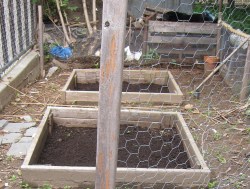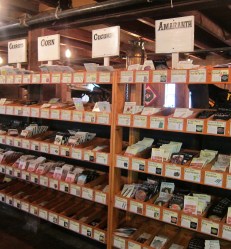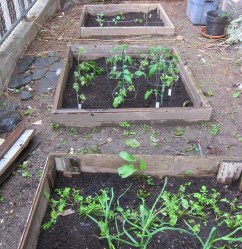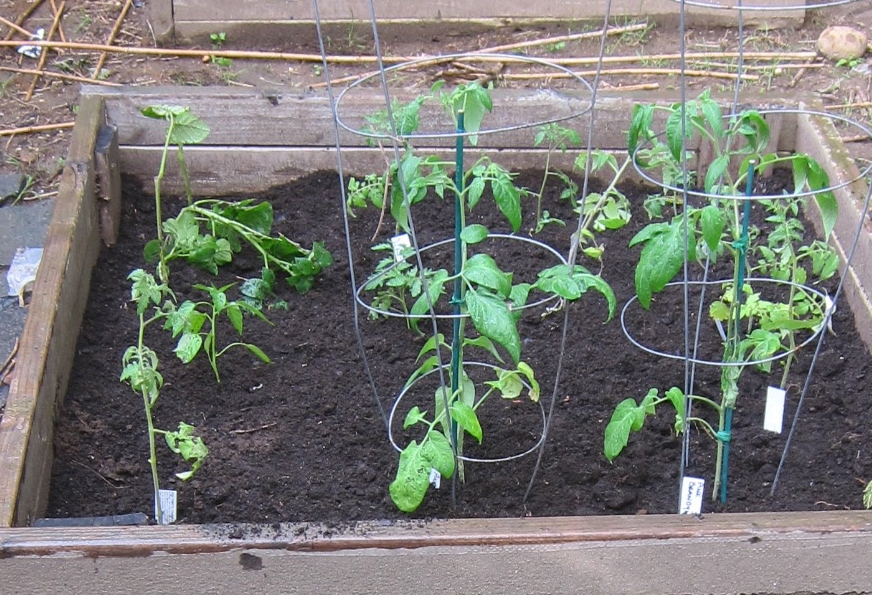
Peebottle garden beds before.
Peebottle Farms is a series about the backyard farm Nina Lalli maintains in the Bed-Stuy neighborhood of Brooklyn.
OMG you guys! I’m so excited to tell you all about the lush organic garden I planted at exactly the right moment for optimal nutrition and beauty, because I’m perfect. Just kidding. I planted some seeds rather randomly and then my stir-crazy chickens destroyed the whole thing.
It’s my third summer as a backyard gardener, and apparently I’m still on the curvy part of the learning curve. First of all, when exactly were we supposed to start planting this year? Instructions like “after the last frost” are vague enough in a normal year. But I think New York’s last frost may have occurred sometime in October this year because the world is ending. Since we had such a freakishly warm winter, I held out for the possibility that Mother Nature would throw some ice at us in May just to keep shit crazy.
When I did eventually plant seeds directly in the recently tested soil of my garden beds, I started out simple, with lettuces, herbs, and leafy greens. I also put in lots of flowers outside the beds — in the soil you couldn’t pay me to grow food in. A few hours of digging and hacking at the glass-and-rock filled dirt left me appalled by how out of shape I am, but I also felt pretty accomplished. Planting seeds gives me a giddy feeling. It’s a slow-burning night-before-Christmas feeling for a plant nerd like myself. As soon as I planted the seeds, I imagined my garden as a veritable orphanage for bees and butterflies, with milkweed, cosmos, zinnias, and sunflowers surrounding my glorious produce supply.
Who let the girls out?
Soon after the planting, when adorable baby arugula leaves were just poking their heads out of the dirt, someone let our six chickens out to pillage the backyard for several hours.
Okay, it was me. One of the hens made a beeline for the door of their run while I was changing their water, and slipped past me. I could probably have kept the rest in, but my heart wasn’t in it. I feel for those ladies, who are well-fed but very bored, and just dying to forage for worms and bugs out in the yard.
They snacked on some buckwheat plants I had put in for them, pecked at some weeds, and made their way toward the compost pile. I thought, “Maybe that’ll be enough.” But soon they went straight for the garden beds, murmuring and pecking. I tried to wrangle them, but six is a lot, and chickens — unlike dogs — don’t seem to speak English. In the end I managed to barricade one of the beds and my pretty blue hydrangea bush. The chickens went back to their little home when the sun set, having eaten every other plant and seed in the garden.
It was especially stupid of me to let this happen since I had already lost two-thirds of our garlic, our sage plant, and our sorrel patch to earlier chicken adventures. And the hens don’t just nibble on leaves, they go deep; they dig seeds out of the ground and break roots. You can tell yourself they’re on pest-patrol, but there’s a price to pay, even in the off-season.

Heirloom seed selection at Comstock, Ferre & Co.
A seedy adventure
So garden Christmas was cancelled, and it was my own fault. For a couple of weeks I wandered the streets, peering into the wild, green community gardens in my neighborhood and kicking myself.
Then, I heard that Comstock, Ferre & Co. — a seed company in Wethersfield, Conn. — was about to celebrate its 201st anniversary. At the last minute, I hauled my boyfriend Tei and our dogs up I-95 for a visit. The event had bluegrass bands, cooking demos, and a panel about GMOs. But the real treat was perusing drawer upon drawer of rare heirloom seeds and meeting Jere Gettle, who bought the company with his wife Emilee two years ago. The Gettles also own Baker Creek Heirloom Seed Company, which Jere, now 32, started when he was only 17.

The Gettle family, of Baker Creek Seed Company.
Since the visit I’ve been reading the Gettles’ book, The Heirloom Life Gardener, and have become obsessed with the whole family. (Did I mention that Emilee is a Little House on the Prairie-style knockout and they have an adorable daughter and they’re all always smiling and holding huge bundles of squash and wearing suspenders and bonnets?)
But I knew none of this when I first asked Jere for plant advice in the greenhouse. He had such a baby face I didn’t consider that he might be the owner — and he didn’t mention it either.
Jere grew up on farms in Montana and Missouri, and was homeschooled by homesteader parents, so he was obsessed with seeds from an early age. During Jere’s teen years he learned that some of his favorite seed varieties were in danger of disappearing because of all the newer hybrids on the market made to look perfect and survive long-distance travel.
As the seed industry consolidated and companies like Monsanto and DuPont introduced genetically modified seeds in the 1990s, Jere’s obsession became his life mission. He began saving seeds at 13 and, a few years later, began sending them with a small mail-order catalog. At 22 he started traveling and collecting rare seeds in places like Mexico, Thailand, and Guatemala. Today Baker Creek sells 1,300 varieties of open-pollinated, non-GMO, non-hybrid, non-treated, non-patented seeds.

Peebottle garden beds after.
Anyway, this is the guy who was helping me decide what to plant in my silly little urban garden, and he was so enthusiastic about how many eggplants I would be able to grow that I basically forgot about what a garden failure I was and felt giddy all over again.
We picked out little wild cherry tomatoes and pink Brandywines, Pingtung and Listada De Gandia eggplants (long purples and round striped varieties, respectively), cucumbers, zucchini, some herbs, and some seeds for leafy greens he thought still had a chance of making it (black mustard, amaranth, and rainbow chard).
Back in Brooklyn the next day, it was Christmas again. I planted the new heirlooms while it drizzled, Tei pruned our huge mulberry tree to give the heat-loving eggplants the sun they deserve, and I wasn’t even cranky about my premature back pain.



